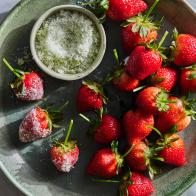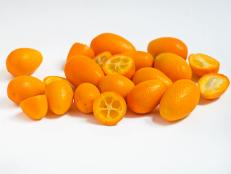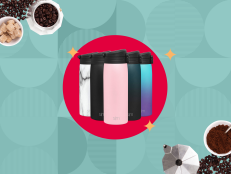What’s the Deal with Pink Lemons?
The trendy citrus has been spotted at Trader Joe's.

Roses are red, lemons are… pink? In case you needed yet another millennial pink food trend to obsess over, we’ve spotted one that’s sure to pop up all over your Instagram feed. That’s right — we’re talking pink lemons, people.
We’ve been seeing these rose-hued citrus fruits just about everywhere, and we’ve also noticed that savvy Instagram users have crafted them into a number of culinary concoctions, from scones to loaf cakes.
In case you haven’t spotted ’em yet, here’s a quick rundown: on the outside, these pink beauties are yellow and green striped, similar to a watermelon. Cut one open and you’ll find a bright, blush-colored flesh that nearly resembles a pink grapefruit.
So, why is everyone going bananas over pink lemons? Can they really be that different from a regular ol’ yellow one? Here’s everything you need to know about social media’s latest citrus obsession.
What Are Pink Lemons?
Also known as the “variegated pink lemon” or the “variegated Eureka lemon” due to its splotchy, colorful foliage, this unique citrus was discovered in 1930 in Burbank, California. Believe it or not, citrus growers at the time weren’t trying to cultivate pink lemons — in actuality, these lush citrus fruits were a result of a spontaneous mutation on a Eureka lemon tree.
Nowadays, citrus farmers and home gardeners alike can plant variegated pink lemon trees to grow bunches of this pink-fleshed fruit. Since this particular tree thrives in warm climates, it’s most commonly grown in Southern California.
Um, Why Are They Pink?
Easy! The pink lemon’s flesh contains a high concentration of lycopene, an antioxidant that gives many fruits and vegetables their red pigment. Pink grapefruit and tomatoes also get their ruby hues from lycopene.
What Do They Taste Like?
Just like the more common, non-pink Eureka lemon, these colorful citrus fruits boast a tart, lip-puckering flavor. However, pink lemons become less acidic as they age, meaning they typically offer a sweeter flavor than what you’d expect from a lemon. According to Frieda’s Specialty Produce, pink lemons can even boast “subtle floral and berry undertones.”
How Can You Use Them?
Now, before you grab a few pink lemons to whip up a batch of pink lemonade, it’s important to note that while the flesh of these fruits is vibrantly pink, the juice runs clear. So, while you can make a decadent lemonade from pink lemon juice by sweetening it with agave or sugar, don’t be surprised when your drink isn’t pink.
We suggest using these sweeter lemons to add an extra indulgent twist to classic lemon-centric desserts like lemon bars or frozen lemonade pie. The pink lemon’s floral hints could also add a tasty touch to this lemon lavender pie.
Not in the mood for dessert? Try candying pink lemon slices for an eye-catching garnish for lemonade and cocktails.
Where Can You Find Them?
Can’t wait to try this pink-hued citrus for yourself? Luckily, they’ve been spotted at Trader Joe’s and Meijer, and you might have luck hunting for them at a specialty produce store or your local farmer’s market. Otherwise, you can purchase them in bulk online through Melissa’s World Variety Produce or Pearson Ranch.
Related Links:































































